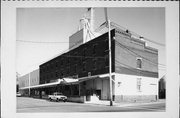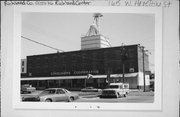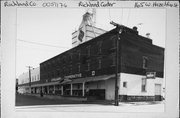Property Record
165 W HASELTINE ST
Architecture and History Inventory
| Historic Name: | KROUSKOP LUMBER YARD WAREHOUSE |
|---|---|
| Other Name: | CONSUMERS COOPERATIVE |
| Contributing: | Yes |
| Reference Number: | 51176 |
| Location (Address): | 165 W HASELTINE ST |
|---|---|
| County: | Richland |
| City: | Richland Center |
| Township/Village: | |
| Unincorporated Community: | |
| Town: | |
| Range: | |
| Direction: | |
| Section: | |
| Quarter Section: | |
| Quarter/Quarter Section: |
| Year Built: | 1905 |
|---|---|
| Additions: | |
| Survey Date: | 1995 |
| Historic Use: | warehouse |
| Architectural Style: | Commercial Vernacular |
| Structural System: | |
| Wall Material: | Brick |
| Architect: | |
| Other Buildings On Site: | |
| Demolished?: | Yes |
| Demolished Date: | 0 |
| National/State Register Listing Name: | Not listed |
|---|---|
| National Register Listing Date: | |
| State Register Listing Date: |
| Additional Information: | This building suffered a fire in the late 1990s and was partially demolished. The last portion of it came down sometime around 2010. Architectural Description: Flat stone window hoods; six over six windows; metal covered elevator building on roof; wooden partially sided rear addition. Constructed as part of the A.H. Krouskop enterprises at the intersection of Haseltine and Main Streets, this vernacular three-story brick building is characterized by a corbeled brick cornice and flat window heads. The lower story of the building has been altered. A wooden addition now covered with siding was constructed on the east side between 1905 and 1912 (A). Built by the local industrialist A.H. Krouskop, as a warehouse for his agricultural implements this building was purchased by the Consumer Cooperative Feed Company in 1948 (B). Architectural/Engineering Significance: The Krouskop Implement Warehouse is significant as under Criterion C as an example of an early industrial building in Richland Center. One of the very few extant early industrial buildings remaining in Richland Center, the Krouskop Warehouse exhibits plain brick surfaces that are characterized by minimal historic ornament including a cornice and window heads. Other good examples of early industrial buildings remaining in Richland Center are the Pacific Coast Condensed Milk Plant on 920 Sextonville Road (20-17) and the remaining buildings in the proposed Krouskop Lumber Yard Historic District. Built between 1899 and 1905, the Krouskop Implement Warehouse was sold to the Consumer Cooperative in 1948 (AB). Historical Background: The Krouskop Agricultural Implement Warehouse is a part of the Krouskop Lumberyard whose main mill was erected in 1883. Krouskop may have established the operation as early as 1878. However, he did not acquire most of the land which the milling operation occupies until 1879-80. His mill eventually covered the area between the river to the west, Haseltine to the north, Main on the east extending to Central to include block 49, and Gage Street to the south. The yard reached full built capacity by 1911. In addition to the warehouse, major buildings at that date included a saw and planing mill with a power house, lumber sheds, kiln, yard office, granary, horse barn, grain warehouse, and livestock yards. The yard sat adjacent to the railroad, a facility indispensable to the transportation of its bulk products. Krouskop shipped many of his goods to Chicago for a broad distribution across the Midwest and Plains as well as engaging in local retail (2). Krouskop wholesaled and retailed rough and finished lumber, sashes and doors, windows, oak flooring, moldings, siding, shingles, lathe, fencing, agricultural implements, and other building supplies. And, he also stored grain, feed, hay, coal, cement, and sand and kept livestock. Krouskop specifically advertised his wholesale business in 1909. He had maintained lumber warehouses occupying several blocks since the mid-1880s which suggests the extent of his business. Krouskop represents one of a limited number of commercial enterprises in Richland Center. After Krouskop's death in 1930, W.S. McCorkle and Carl Barnes gained his lumber operation (3). The warehouse was constructed in two parts. Krouskop erected the west half between 1899 and 1905 as an implement warehouse. He built the east half between 1905 and 1912 as a grain warehouse. This building changed functions rather frequently. By 1912, the west half contained primarily cement while the east half held hardware and roofing materials. In 1927, they had both become a feed warehouse. After Krouskop's death in 1931, a "modern feedmill" had been established in the west end. It produced mixed and sweet feeds for dairymen and farmers. Machinery in the basement included a corn crusher, grinding mill, molasses mixer, molasses pump, bins, clover and timothy seed cleaner, and conveyors. The Consumer Cooperative located in Richland Center in 1935, and they purchased the building in 1948 (4). Historical Significance: It acquires local historical significance in association with the Wholesale Topic of the Commerce Theme. Although not a large commercial center, Richland Center did provide wholesaling services for the northern part of Richland County, particularly for agricultural products by the 1890s. Before the 1880s, farmers relied primarily upon the large commercial services of its large mercantile stores and by the 1870s its grain mills. The mills ground farmer's feed. Thus, Krouskop expanded these services in the 1890s. Since area farmers engaged in commercial farming, first in grains and later in dairying for which they relied upon their own feed, such services were vital to them and reflect the inter-relationship between the rural area and the trade center. |
|---|---|
| Bibliographic References: | 1. Richland County Abstract Company, Indices to Land Records in the Richland County Courthouse (Richland Center: Richland County Abstract Company, n.d.); Democrat, April 9, 1930; Sanborn-Perris Map Company, Diagrammatic and Detailed City Maps Published for Use by Fire Insurance and Mortgage Companies (New York and Chicago: Sanborn-Perris Map Company, 1885-86); Ibid., 1892; Ibid., 1899; Ibid., 1905; Ibid., 1912; Ibid., 1927. 2. Democrat, May 3, 1937; Margaret Scott, Richland Center: A History (Richland Center: Richland County Publishers, 1972), p. 97. 3. Perl L. Lincoln, P.L. Lincoln Papers (Richland Center: Local History Room, Brewer Library, n.d. [Mss. uncatalogued]); Carl Burdock, The Chicken, the Egg, and the Omelet (Madison: Archives [Mss.], SHS, 1964); George Sinnett, Oral Interview (739 South Park, Richland Center, February 12, 1988); Local History Room, Brewer Library, Manuscripts (Richland Center: Local History Room, Brewer Library, Mss. 1645, 1073, 226); Sanborn-Perris Map Company, Ibid., 1885-86; Ibid., 1892; Ibid., 1899; Ibid., 1905; Ibid., 1912; Ibid., 1927; Scott, Ibid., pp. 158, 223; R.L. Polk & Co., Wisconsin Gazetteer and Business Directory (Chicago: R.L. Polk & Co., 1909), p. 1131. 4. Burdock, Ibid.; Sanborn-Perris Map Company, Ibid., 1899; Ibid., 1905; Ibid., 1912; Ibid., 1927; Local History Room, Ibid., Mss. 1073; Scott, Ibid., p. 118; Richland County Historical Society, Richland County, Wisconsin (Dallas: Taylor Publishing Company, 1986), p. 384; Republican Observer, April 12, 1935; Democrat, January 7, 1931; Sinnett, Ibid.,; Twylah Keppler, Oral Interview (Local History Room, Brewer Library, Richland Center, February 10, 1988). A. Sanborn-Perris Insurance Map, City of Richland Center (New York: Sanborn Map Co., 1899, 1905, and 1912. B. Richland County, Wisconsin (Richland County Historical Society, 1986) p. 384. |
| Wisconsin Architecture and History Inventory, State Historic Preservation Office, Wisconsin Historical Society, Madison, Wisconsin |



